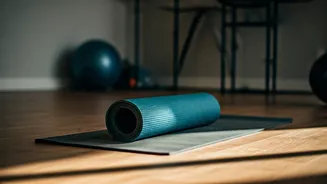Pilates Introduction
Pilates is a system of exercises focusing on core strength, flexibility, and body awareness. It was developed by Joseph Pilates in the early 20th century.
The method emphasizes precise movements, controlled breathing, and proper posture. These exercises can be performed by anyone, regardless of fitness level. Practicing Pilates regularly provides various benefits. It improves posture, strengthens core muscles, increases flexibility, and reduces stress. Unlike high-impact exercises, Pilates is gentle on the joints, making it suitable for people of all ages and fitness levels. The exercises typically focus on controlled movements and deep breathing, which promote relaxation and mindfulness. Many find Pilates helpful in managing back pain and enhancing overall body coordination. With its emphasis on mindful movement and body awareness, Pilates offers a holistic approach to fitness and well-being.
The Hundred
The Hundred is a foundational Pilates exercise that warms up the body and engages the core. To perform this, lie on your back with your knees bent and feet flat on the floor. Engage your core, lift your head and shoulders off the ground, and extend your arms alongside your body. Begin pumping your arms up and down, inhaling for five counts and exhaling for five counts. This sequence should be repeated ten times, totaling one hundred pumps. The Hundred increases circulation, strengthens the core muscles, and improves breathing. As you lift your head and shoulders, keep your chin tucked slightly to avoid straining your neck. Maintain a steady breathing rhythm throughout the exercise. This prepares the body for more intense exercises while improving overall stamina and concentration. Mastering The Hundred provides a solid base for other advanced Pilates exercises.
Rolling Like a Ball
This exercise is excellent for massaging the spine and enhancing core stability. Sit tall with your knees bent and feet lifted off the floor. Hold onto your shins and round your back, creating a C-curve shape. Inhale deeply, then exhale as you roll back onto your shoulder blades, keeping your core engaged. Inhale to roll back up to the starting position. Repeat this sequence six to eight times. Focus on controlling the movement and maintaining a rounded back. This exercise improves balance and coordination. It also strengthens the abdominal muscles, and improves spinal flexibility. By keeping the core engaged, you ensure the movement is controlled and avoids any strain on the lower back. Rolling Like a Ball is an excellent exercise for improving spinal health and preparing the body for more complex movements.
Single Leg Circles
Single Leg Circles target the core and hip flexors while improving coordination. Lie on your back with one leg extended towards the ceiling and the other bent with the foot flat on the floor. Engage your core, and using the extended leg, draw small circles in the air. Perform five circles in one direction, and then reverse the direction for another five circles. Repeat this on the other leg. This exercise helps to strengthen the abdominal muscles. It also improves hip mobility and coordination. Keep your lower back pressed into the mat to prevent arching. Your movements should be controlled and precise, focusing on engaging your core throughout. Single Leg Circles are perfect for building core strength and enhancing body awareness. They also improve the overall balance and stability of your core.
Spine Stretch Forward
This exercise stretches the spine and hamstrings while improving posture. Sit tall with your legs extended in front of you and your feet flexed. Inhale, and then exhale as you reach forward, keeping your back straight and engaging your core. Aim to touch your toes, but don't force it. The goal is to feel a gentle stretch. Inhale to sit back up to an upright position. Repeat three to five times. Spine Stretch Forward improves spinal flexibility and hamstrings. It also enhances body posture. Keep your back straight throughout the movement. If you find it challenging to reach your toes, try bending your knees slightly or modify the exercise to suit your level of flexibility. Remember, maintaining proper form is crucial to avoid any strain. This exercise is excellent for releasing tension and increasing flexibility.
Swan Dive Prep
Swan Dive Prep strengthens the back muscles and improves spinal extension. Lie face down with your hands beneath your shoulders. Engage your core, and lift your chest off the floor while keeping your elbows close to your body. Inhale as you lift, then exhale as you lower back down. Repeat this movement five to eight times. This prepares the body for the full Swan Dive and strengthens back muscles. The exercise enhances spinal extension and improves posture. Keep your neck long and avoid shrugging your shoulders. Focus on lifting your chest and maintaining control throughout the movement. Proper form is essential to prevent straining your back. The Swan Dive Prep is an excellent exercise for improving back strength and flexibility.













